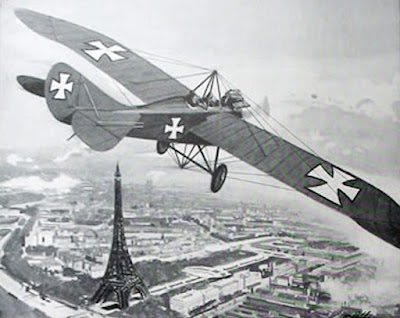
Illustration of von Hiddeesen flying over Paris.
The morning of August 30 was foggy, but by by 11.00 the fog had burnt off, and von Hiddessen took off from an airfield near St. Quentin together with his observer. He circled the airfield once before proceeding in a south-westerly direction. 70 minutes later the Taube reached the outskirts of Paris at an altitude of a dazzling 5,500 feet. Von Hiddessen crossed the Parisian skies a couple of times before releasing the first bomb at 12.45. The second fell minutes later in the courtyard of 107 quai Valmy, a home for the aged and the third landed on the pavement outside 66 rue des Marais, not far from the Boulevard Magenta. The final explosive crashed through the skylight of 5 and 7 rue des Récollets and failed to explode. All the bombs landed within a few hundred meters of each other in the 10th arrondissement of Paris.
Initial French reports from September 1 claimed that any damage caused was superficial, but later claims stated that one or two young Parisian women were killed, and they supposedly became the first of around 500 Parisians to die due to aerial bombardment or shells from long-range German artillery (the so-called "Paris Gun"). At least one horse succumbed to the bombardment as well. The banner and the leaflet bag was taken to the Prefecture of Police for examination. For some reason, von Hiddessen had misunderstood his orders and dropped the bag of leaflets instead of spreading out its contents. Ferdinand Von Hiddessen himself was shot down over Verdun a year later, sustaining serious wounds and spending the rest of the war in French captivity.
A horse supposedly killed by one of von Hiddessen's bombs.
The Parisians'responses to the bombing was mainly underwhelmed. The inhabitants of the city initially thought they were dealing with a gas explosion. Subsequent German aerial visitors arrived periodically during the late afternoon, leading the Parisians to label them "Five o'çlock Taubes", The Taube being a generic name for German aircraft in the early states of the First World War. Irritating as the bombings and spreading of propaganda leaflets may have been, Parisians were more curious than fearful, and they would be sitting outdoors at cafés and restaurants to place bets on where the bombs might land. In October 1914, British Lieutenant Colonel Ernest Swinton became an eye witness to a German aerial attack on Paris, and he became so impressed that he spent money out of his own pocket to print British propaganda leaflets that were distributed over German targets. However, true to form Swinton's superiors were less than impressed, and a second leaflet drop was denied.
One of von Hiddessen's leaflets.
Sources:
Walter J. Boyne. The Influence of Air Power Upon History.
Arunkumar Bhatt. Psychological Warfare and India.
combatairmuseum.org/aircraft/taube.html
fiddlersgreen.net/models/aircraft/Etrich-Taube.html
agefotostock.com/age/en/Stock-Images/Rights-Managed/MEV-10281640
psywarsoc.org/FallingLeaf/firstwwi.php
martinusevers.org/tag/parijs/

